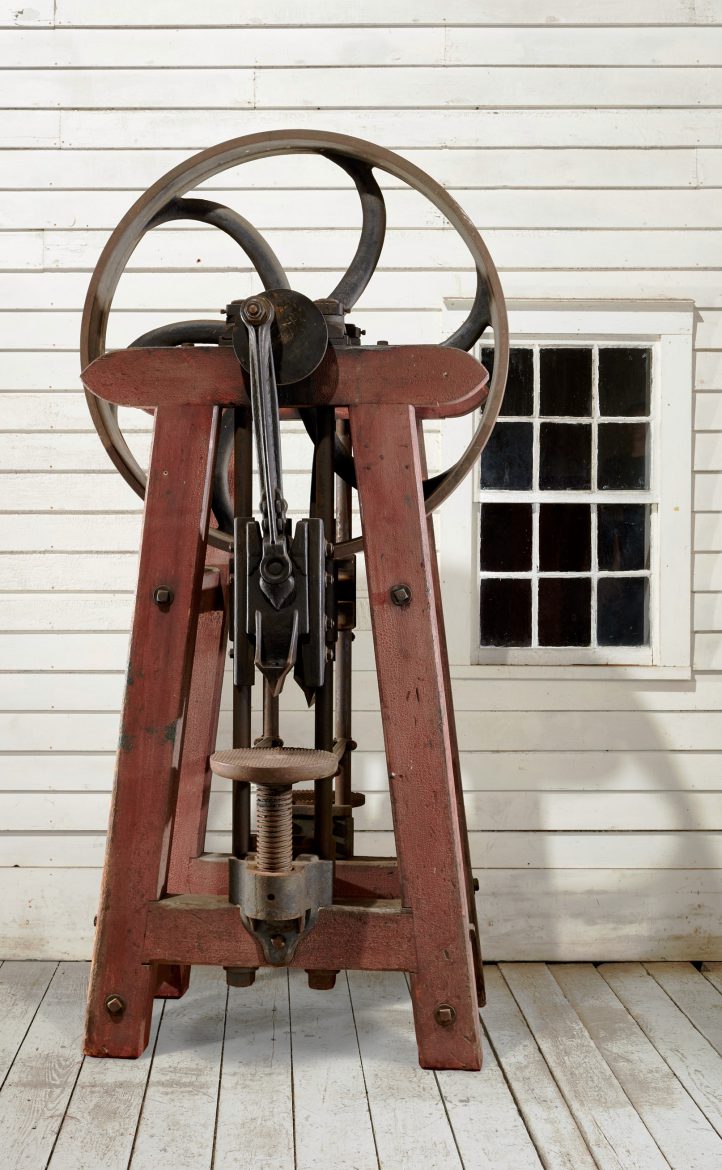
Hildreth Patent Double Wood Splitter, North Family, Mount Lebanon, NY, 1883, Shaker Museum | Mount Lebanon: 1950-1118.1. John Mulligan, photographer.
Maintaining a sufficient supply of seasoned wood for heating and cooking occupied a considerable amount of time and space for the Shakers at the North Family at Mount Lebanon. The brothers and hired men would begin getting in logs from the mountain wood lots in February and March. By 1830 the Shakers used a circular saw located outside their Brick Shop, powered by its […]

Hildreth Patent Double Wood Splitter, North Family, Mount Lebanon, NY, 1883, Shaker Museum | Mount Lebanon: 1950-1118.1. John Mulligan, photographer.
Maintaining a sufficient supply of seasoned wood for heating and cooking occupied a considerable amount of time and space for the Shakers at the North Family at Mount Lebanon. The brothers and hired men would begin getting in logs from the mountain wood lots in February and March. By 1830 the Shakers used a circular saw located outside their Brick Shop, powered by its waterwheel, for cutting the logs and what they called “small wood” (branches) to proper firewood length. The logs were then split by hand and carted to one of several wood houses to season under cover. The work of splitting more than one hundred cords of firewood every year was made much easier in the early 1880s when the North Family purchased a Hildreth Patent Double Wood Splitter. An advertising brochure published sometime after 1886 carried two testimonials from the Shakers, one from the Canterbury Shakers dated around 1878 and the other from Elder Frederick W. Evans during the winter of 1883. Both highly praised the machines. Elder Frederick visited Canterbury in June, 1878, and likely saw their Hildreth splitter in operation at that time. In the winter of 1883, he wrote in his testimonial, “I bought it for a Canaan Family. They had a lot of some fifty cords of wood sawed up. It was an exceptionally hard lot to split, – mostly Elm. It was their opinion that the machine would fail to do the job. They set it up and put it to work. The foreman stood and watched the operation for a little while, then turned on his heel and said, ‘That will do! It splits any thing put under it.’”
On March 21, 1883 the brothers from the North Family went down to the Upper Canaan Family to watch the machine in operation. As the original intention was that the machine would be shared between the Upper Canaan Family and the North Family, on March 29, 1883 the machine was brought from the Upper Family and put near the firewood saw at the Brick Shop and powered by the waterwheel. It “worked splendidly.” Two days later, however, the splitter broke and had to be taken to Pittsfield, MA, for repairs. The next year the splitter was set up inside the north end of the North Family Wood House and powered by the ten-horsepower Backus water motor the North Family used to operate the machinery in the laundry in the other end of the building. In the floor of the Wood House, where the machine once stood, the Shaker cut two square recesses either to keep the machine from moving across the floor or to level it – or both. The precise location of the machine is preserved by these recesses.

Advertising Brochure, Hildreth’s Patent Wood Splitter Manufactured by Hildreth Bros. Harvard, Mass, ca. 1886, Hancock Shaker Village: 4244.
The Hildreth Brothers of Harvard, Massachusetts, manufactured these machines. They were made in several different sizes ranging from the smallest – the one the Shakers purchased, capable of splitting wood up to 17 inches long — to one that would split wood 50 inches long. The Shakers paid $240 for their machine. The patent for the splitter (U. S. Patent No. 205550 issued July 2, 1878) was held by its inventor Edwin A. Hildreth, and witnessed by Stanley B. Hildreth and M. G. Hildreth – likely the “Brothers.” The promotional brochure for the machine suggests that “Parties testing these splitters on rock maple wood from one to two feet in diameter, and so hard that it was with great difficulty that a hand axe could be made to enter it at all … work[ed] so easily and rapidly that, as they expressed it, ‘the boys had hung up their hand axes and would swing them no longer.’” Operating between 125 to 175 strokes per minute the double splitter could split ten to 18 cords of firewood per day or up to eight to ten cords of kindling.
[An aside: In 2010 the elementary school in Harvard, MA, was renamed the Hildreth Elementary School to honor the gift of six acres of land and half the construction cost of a school built in 1904. The Hildreth family – Edwin A., Stanley B., and Sister Emily E. – were the donors.]
Although the Museum’s Hildreth wood splitter has not been used to make firewood since the 1930s, there are still some of these machines in operation – mostly being demonstrated by old-time machinery enthusiasts. To watch one of these splitters in operation follow this link and remember that while the machine in operation here is working at a speed of about 60 strokes per minute, the machine was intended to operate two to three times that fast.
It’s so great for you to share the history I just purchased a Hildrith wood splitter and can’t wait to demonstrate it at our Crossroads Heritage Museum Thanks Again